How did Flash appear
 Flash technology has left its mark in the history of the Internet and design standards in just a few years, but such serious things do not appear every day. And so: where did Flash come from? What was its basis? This article answers these and many other questions.
Flash technology has left its mark in the history of the Internet and design standards in just a few years, but such serious things do not appear every day. And so: where did Flash come from? What was its basis? This article answers these and many other questions.How it all began
 It all started with the fact that a young man named Jonathan and with an inappropriate name for Russian and English people Gay dreamed of becoming an architect. While he was sketching buildings, he realized that he had little chance that his sketches would ever be brought to life. And from the moment Apple II entered his life, Jonathan started programming, and he soon realized that writing programs gives you the opportunity to invent something, create and later you can see how it all works and interacts with the user. . At last, his ingenuity began to take shape, although his skills in Basic programming on the Apple II were far worse than his skills in architecture.
It all started with the fact that a young man named Jonathan and with an inappropriate name for Russian and English people Gay dreamed of becoming an architect. While he was sketching buildings, he realized that he had little chance that his sketches would ever be brought to life. And from the moment Apple II entered his life, Jonathan started programming, and he soon realized that writing programs gives you the opportunity to invent something, create and later you can see how it all works and interacts with the user. . At last, his ingenuity began to take shape, although his skills in Basic programming on the Apple II were far worse than his skills in architecture.')
His first real program written in Basic was the game, which was an exact copy of the game Space Invaders. Shortly after Basic, he began writing programs in the Pascal language, with the help of which he created his first graphic editor, SuperPaint, for which he received an award at a scientific exhibition at school.
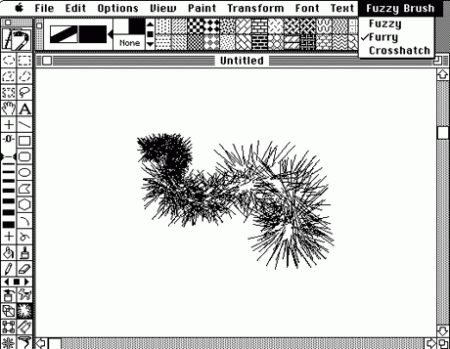
"SuperPaint"
“If you have ever thought that using Flash is very difficult, you would try drawing on the Apple II with a joystick before the concept of the undo function was developed. See how calm you are. ”
Jonathan Gay, Flash Creator
Jonathan Gay began professional programming while he was still in school. When his Apple II was replaced by Macintosh, Jonathan and his father began attending early meetings of the Macintosh Users Group, where his father bragged to the organizer about Jonathan’s project for a science exhibition. As it turned out later, the organizer was Charlie Jackson, who planned to create a Macintosh software development company and call it Silicon Beach Software.
Although Charlie did not have enough money to create his plans, he still bought Lisa's computer for $ 10,000 so that Jonathan could program in it. It was on this computer that Jonathan wrote the first Macintosh game "Airborne!", Which used digital sound and animation that was smooth for its time. For its time, the game sold very well.
From games to drawing
When work began on the next game, a professional actor was specially hired to create it, and later a game called Dark Castle was published. This game was a very big hit, and its sales paid for Jonathan’s college tuition. After the game "Dark Castle" appeared "Beyond Dark Castle". Game creation has become an important part of Jonathan's education in programming, stimulating him in combining animation and digital sound and synchronizing these elements. Most importantly, the concept of fast software that interacts with the user has become paramount for Jonathan.
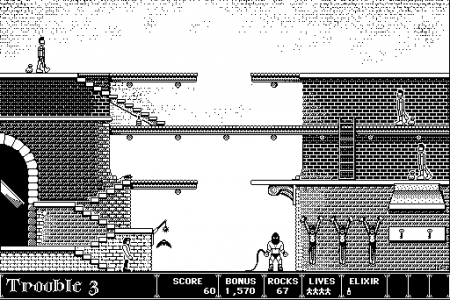
"Dark Castle"
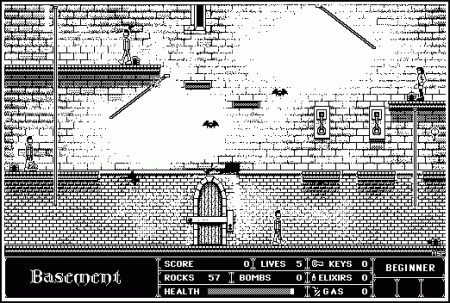
"Beyond Dark Castle"
After developing Beyond Dark Castle, Jonathan set about creating the editor of SuperPaint II, a follower of his research project in which he implemented the PostScript drawing style. After SuperPaint II was completed and Jonathan finished college, he went to work at Silicon Beach Software, and began developing technology to create a new generation of graphics software. It will be written in C, and will use an object-oriented framework to simplify the development process and its usability, both on Macintosh computers and on computers running Windows.

"SuperPaint II"
This technology spawned a program called Intellidraw, which allowed Silicon Beach Software to compete with Adobe Illustrator and Aldus Freehand, which was later acquired by Macromedia, in the PostScript market. The uniqueness of Intellidraw was that in addition to the possibility of drawing images, it also allowed you to add actions to drawn images, so that besides the possibility of creating lines that would connect to any object and other lines, you could add, for example, a histogram , which could change when the user entered numbers into a text object. Later it turned out that Intellidraw was not the first program to do this, and the SketchPad image editor existed, but people very quickly forgot about it. Visio was able to implement this idea in its product, which turned out to be very successful, while Intellidraw did not win the respect of users. When it became clear that Intellidraw was doomed, Jonathan decided it was time to start acting differently. During his time with part-time employment, he earned as much money as he did while working on Intellidraw, so he decided to try to create a better product and make sure that he was lucky, so he founded his own company.
At this time in the technology of personal computers the latest “peep” was pen computers, which were a screen on which you could draw with an electronic pen. GO has been developing an operating system for a new generation of laptops that could use this technology. Computers could get smaller, and users could actually take them with them anywhere. It was a very attractive idea, and using the example of Silicon Beach Software it was perfectly clear which new operating system offered a chance to create new software companies.
With the help of investments by Charlie Jackson, in January 1993, FutureWave Software was created, whose goal was to dominate the market for graphics software for pen computers.
At that time it was clear that it was quite difficult for users to learn the complex capabilities of the program, so the real challenge was creating a complex product that would be easy to use. Drawing on the computer was obviously slower and less convenient than drawing with a pen on paper. And although Apple’s mouse was a clear breakthrough compared to a joystick, drawing with a pen on a computer screen was much easier. With the help of Robert Tatsumi, Jonathan began to develop a program that would allow drawing on the computer with the same ease as on paper.
Changes in the plans
The company GO, as it turned out, spent the money better than it earned it and was later acquired by AT & T, which soon, in January 1994, covered GO and left FutureWave Software without a market. The only way out was to take the program and rewrite it for use on Macintosh and under Windows. At this moment, SmartSketch entered the market as a product for more convenient drawing on a computer and even a little succeeded in the market dominated by Illustrator and Freehand.
In the middle of the summer of 1995, FutureWave Software received a lot of letters from consumers in which they said that they should transform SmartSketch into an animation product. FutureWave Software was very interested in creating animation software, but at that time the only ways animations were distributed were VHS and CD ROM, and the market for animation software was very narrow.
Just at this time, the new concept, which was called the Internet, as well as the World Wide Web, debuted before the public. In theory, it seemed likely that the network would become so popular that users would want to send and view graphics or animation, creating a platform for FutureWave Software to create a useful product for two-dimensional computer animation.
With such thoughts, work began on adding features for creating animation in SmartSketch and creating an interpreter for the network in Java, which at first was very slow, for visualizing animation. FutureWave Software continued development, and in the fall, Netscape's browser came out with an API for connecting plug-ins, which provided an opportunity to create a plug-in with decent performance.

SmartSketch
Talk about selling SmartSketch started long before it became clear that the program did not have a distinctive brand, and should focus less on drawing, and more on animation. Therefore, the program has been renamed “CelAnimation”. Because of the fear that the program would be labeled “to create animation,” it was renamed again, and now it was called FutureSplash Animator.
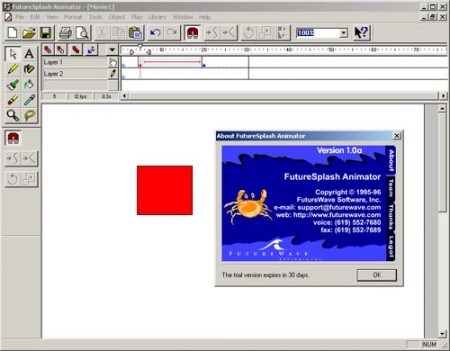
"FutureSplash Animator"
Almost under the wing of adobe
Work on FutureSplash Animator continued, but the company began to worry that they were too small to create the level of popularity they were seeking, so in October 1995 they tried to sell the technology to John Varnock from Adobe.
And Although he was interested in the program for creating illustrations "SmartSketch", but the very slow work of animation "FutureSplash Animator" in Java was not impressive, so Adobe refused the deal. In December 1995, the company was almost bought by Fractal Design, but they were also more interested in SmartSketch, and refused to use FutureSplash Animator.
In the summer of 1996, FutureSplash Animator was released, and the public began to show interest in it. FutureWave Software’s biggest success was in August 1996, when Microsoft was working on creating a network version of MSN, and they wanted to create something more like television on the Internet; the solution was "FutureSplash Animator". Another successful client for FutureWave Software was Disney Online. They used the features of FutureSplash Animator to create the animation and interface for their subscription service - Disney's Daily Blast.
In November 1996, Macromedia began negotiating with FutureWave Software for collaboration. Because FutureWave Software existed for 4 years with investments totaling $ 500,000, they accepted the offer, and in December 1996, Macromedia acquired the company, and FutureSplash Animator turned into Macromedia Flash 1.0.
“The idea of using the rich resources of a well-known company to distribute FutureSplash Animator seemed very interesting to us.”
Jonathan Gay, Flash Creator
Flash Release History
In 1997, Macromedia Flash 2 version was released, in which support for stereo sound, improved integration of bitmap images, buttons, component library and the ability to change frame by frame colors appeared.
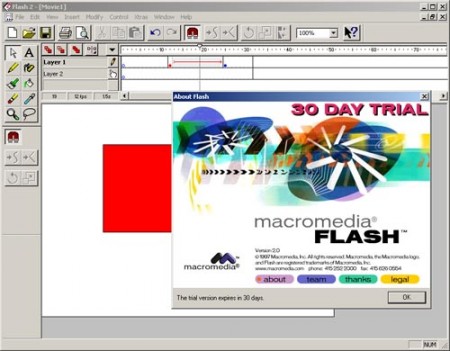
"Macromedia Flash 2"
In 1998, the following changes were introduced in Macromedia Flash 3: improvements in terms of animation, playback and publication, as well as a primitive scripting language for adding interactivity. Also this year, Macromedia sold its 100,000th copy of Flash.
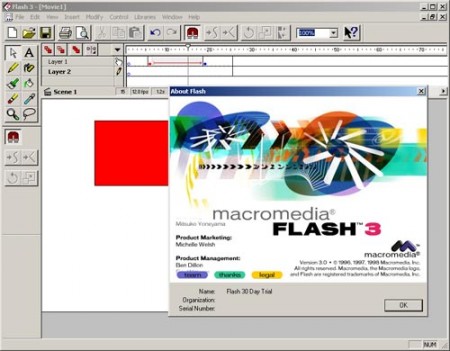
"Macromedia Flash 3"
In 1999, 100 million Flash Player installations were achieved, in part because it was included with Microsoft Internet Explorer 5. Macromedia Flash 4 introduced the ability to stream MP3s and motion tweens. Initially, the plug-in for Flash was not delivered with any browser, and users had to visit the Macromedia site to download and install it, but in 2000, Flash Player was already supplied with all AOL, Netscape and Microsoft Internet Explorer browsers. After 2 years, it has already been delivered built into all versions of Microsoft Windows XP. The coverage of Flash Player was 92% of all Internet users.
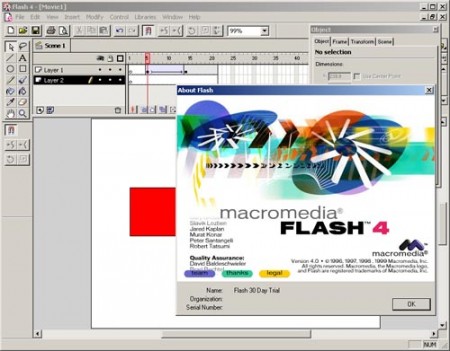
"Macromedia Flash 4"
In 2000, with the release of Macromedia Flash 5, much has changed, because ActionScript has entered the game - an object-oriented programming language that adds interactivity, data processing and much more to the contents of Flash applications, as well as the ability to change the interface of the development environment.

"Macromedia Flash 5"
The Macromedia Generator project was the company's first attempt to separate design from content in Flash. It was released in April 2000, and in its corporate version provided the ability to create Flash on the server side. The project was closed in 2002 in order to allow other technologies to develop, such as Flash Remoting, which allowed smooth data transfer between the server and the client, as well as the ColdFusion server.
In October 2000, design guru Jacob Nielsen wrote a controversial article on the ease of use of Flash, which was called “Flash is 99% bad.” Later, Macromedia hired Jacob to simplify the use of the development environment.
In September 2001, a survey conducted by Media Metrix for Macromedia showed that 7 out of 10 sites in the US use Flash content.
On March 15, 2002, Macromedia announced the release of the 6th version of Flash Player and Macromedia Flash MX, which supported video, application components, libraries, and were easy to use. Also in 2002, Flash Communication Server MX was released, which allowed streaming video to Flash Player 6. Another way of providing was to embed video into Flash movies.
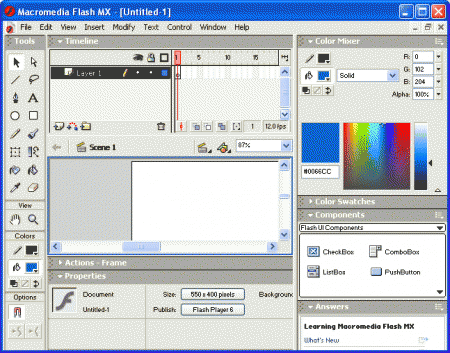
"Macromedia Flash MX"
In September 2003, Flash MX 2004 was released, working up to 8 times faster than its predecessors, with an improved compiler and a new Macromedia Flash Player 7. Also, there were opportunities to create diagrams, graphs and additional special effects for text, support for extensions, which were sold separately, importing PDF files with high precision, as well as Adobe Illustrator 10 files, developing for mobile and portable devices, and developing applications using forms. On top of that, ActionScript 2.0 also appeared, which provided developers with an opportunity for an object-oriented programming approach using ActionScript. V2 components were replaced with Flash MX components and reworked from scratch to provide ActionScript 2.0 capabilities and object-oriented programming principles. Flash MX 2004 was the first version of the program with the division into the "Basic" and "Professional" versions. The “basic” version was created for those who were engaged in traditional Flash animation, and the “Professional” version was created with more advanced features, such as data components.
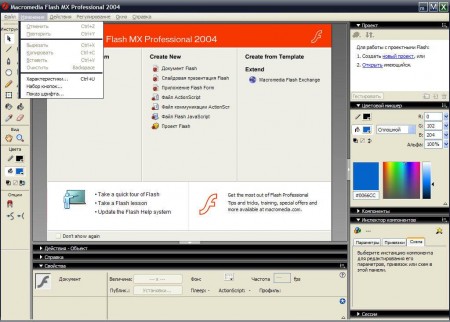
"Macromedia Flash MX 2004"
In 2004, the company introduced the Flash Platform. This development not only introduced Flash as a development environment; Flex 1.0 and Breeze 1.0 were released, which used Flash Player as an information delivery tool, but both were independent of the Flash development environment for developing Flash applications in the first case, and Flash presentations in the second. The company also introduced Flash Lite 1.1, which was designed specifically to run Flash on mobile devices.
The company Macromedia in 2005 represents Flash 8, which according to her carries the most significant changes since the release of the 5th version of Flash. New features include: filters, anti-aliasing, bitmap caching, new On2 VP6 video codec, an improved font rendering engine - FlashType, an emulator for mobile devices, as well as several improvements regarding ActionScript 2.0, for example, BitmapData class, ConvolutionFilter, class DisplacementMapFilter, and several classes for working with geometry. Also in 2005, Flash Lite 2.0 was released, which was similar in its capabilities to Flash Player 7.
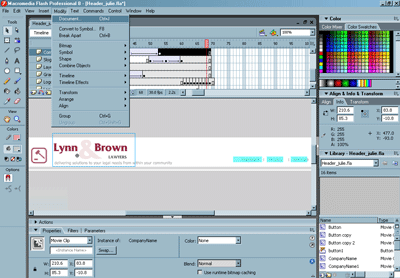
"Macromedia Flash 8"
Under the wing of adobe
On December 3, 2005, Adobe Systems acquired Macromedia and all of its development, including Flash. The deal amounted to approximately 3.4 billion US dollars.
In 2006, Flash Player 9 for Mac OS and Windows was released. For the first time ever, Flash Player came out without the usual joint exit of the development environment. Together with Flash Player 9, Flex 2.0 was also released, and Flash 9 continues to spread without a development environment until 2007. For the first time since the existence of the technology, the Flash Player interpreter has the opportunity to spread widely long before the development environment for it appears.
In January 2007, Flash Player 9 for Linux was released. Flash CS3, converted from Flash 8, with some updates, mainly integrating with other products from Adobe, appears as one of the products of Adobe Creative Suite CS3. The new version also includes ActionScript 3.0 and a new mechanism for working with XML. In late January 2007, Adobe Systems also introduced a revolutionary technology called Apollo (now AIR - Adobe Integrated Runtime). This technology allows you to transfer interactive applications for the Internet from the browser to the desktop, i.e. developers have been able to use their usual tools - Flash / Flex, HTML, Ajax to create common applications. Currently, beta versions of Adobe AIR are available for Windows XP SP2 and Windows Vista, as well as for Mac OS 10.4.8 and 10.4.9. The version for Linux, Adobe plans to release only in conjunction with the release of the first version of the technology. In early June 2007, Adobe also introduced a beta version of the Flex 3.0 development environment, codenamed Moxie, which carries some bug fixes, native support for Adobe AIR, improved compiler speed, and many other changes ...
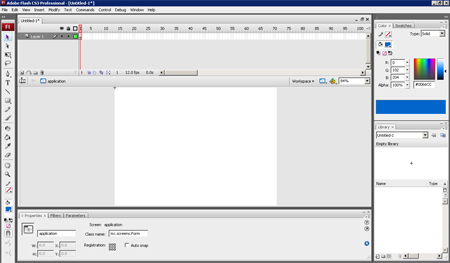
Adobe Flash CS3
Conclusion
In 2001, 50 people engaged in the development of Flash, instead of 3; So much worked in FutureWave Software, when the company came into being. Since then, Flash has evolved from simple software for creating network animation and network illustration into a multimedia development environment. Flash has become a synonym for describing animation on the Internet. Flash Player is currently the most common software on the planet; it is seriously ahead of Internet Explorer, Windows, Firefox and other software in the number of computers on which it is installed ...
Sources used to write the article
Flash history before version 2.0
The time scale of Flash versions from version 2.0.
Screenshots of the first 5 versions of Flash
Screenshots of other versions of Flash
From this link you can download FutureSplash Animator version 1.0 for Windows. Volume 2Mb.
Source: https://habr.com/ru/post/10847/
All Articles